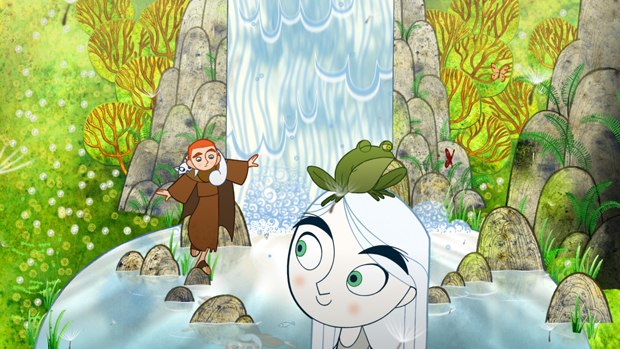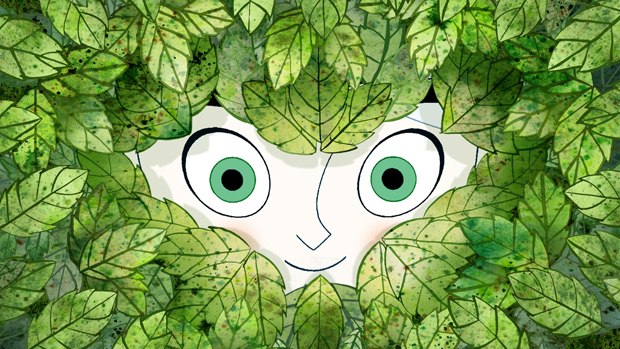Director Tomm Moore chats with us about his acclaimed feature debut.
Check out The Secret of Kells clips at AWNtv!
The Secret of Kells has just grabbed an Annie nomination for Best Animated Feature and Tomm Moore, co-founder of Cartoon Saloon in Kilkenny, Ireland, describes how he brought this lovely and magical 2D movie to the screen. Inspired by Ireland's most precious artifact, The Book of Kells (a stunningly beautiful medieval manuscript containing the Four Gospels), the movie concerns a 12-year-old boy living in an abbey that comes of age amid Viking attacks and mystical wonders.
Bill Desowitz: What inspired you to make a movie about the legendary Book of Kells?
Tomm Moore:
Well, it was a long time in the making. I had the first idea with a friend in college and we were thinking after seeing Mulanand The Thief and the Cobbler that we could find something in Irish arts to base as an animation. We never could do it as a student project so it became a pet project on the back burner here at the studio. But we thought it would be interesting to translate that into 2D, hand-made animation, which would be suited to the style. And the stories and legends from around that period seem pretty ripe. We went through different drafts of the script, some more of the history and some more of the fantasy and found a blend between the two.
BD: How did the financing come together?
TM: We pitched it at Cartoon Movie when Les Armateurs and Vivi Film were in the middle of The Triplets of Belleville and they showed 10 minutes and it was a big hit and they liked our pitch and thought it could be their follow-up. And at that same Cartoon Movie Canal + got involved too, so they were the kind of anchor finance. And then once the French financing started to come into place, we started to raise the Irish finance and then, finally, the Belgian. So in the end, it was about 2 million Euros from each country.
Because Ireland was the country that developed the project, we ended up being the lead creative studio and France ended up being the lead production studio.
BD: So, how was the animation divided up?
TM: We did about 15 minutes of sample animation, designs, all of the key posing and most of the backgrounds here at Cartoon Saloon [Blue Spirit in Angoulême, France did the rest of the backgrounds]. And then we divided the rest of the animation around Europe and Brazil: Walking the Dog in Brussels, Belgium; Lightstar Studios in Sao Paolo, Brazil; and Kecskemet Film in Hungary; ink-and-paint at Digital Graphics in Liege, Belgium; the in-betweens and cleanup were done in Brazil; and all of the compositing and editing and even the final sound post were done in France and Belgium.
BD: That's quite a step up for you and your company. What was it like tackling a feature?
TM: Yeah, it was really an adventure and it was pretty massive. I traveled a lot and learned a lot. Mainly, we kind of got neurotic about preparing everything and it paid off in the end because a lot of people said that they found the film very consistent and were surprised that it was made in so many countries, and I'm proud of that.
BD: What kind of pipeline did you have?
TM: We worked with HoBSoft developed by a couple of Danish guys for Asterix and the Vikings. When anyone at a studio finished their work, they would upload it and I could see it and bring it into the Avid. That was our main production tool because the pipeline was all over the place.
BD: And the CG components?
TM: That was all done in Belgium. Digital Graphics took all the CG elements that were integrated with the characters. And then Walking the Dog took key sequences like the battle with [the giant] snake. They worked on Triplets and I was quite impressed with how they made 3D look like 2D.
BD: What else?
TM: At the end, the key role page was drawn and was originally a manuscript from a thousand years ago but an illustrator cleaned it up and pulled it apart in Blender so it could move. And then when the Vikings attack, a lot of the little extra characters that look like brushstrokes were done in CG. Any time anything was detailed and complicated, it was CG. We even had some background characters animated in Flash and then mapped onto 3D geometry.
BD: Was the biggest challenge arriving at an appropriate look?
TM: Yeah, we had so many different styles at the start. The art director, Ross Stewart, is a friend of mine from school, and we worked together for years on the look because we never thought the project was going to go into production. But by the time we did actually go into production, we developed more styles than we could use, and we had to pare it all down in a few months and come up with a consistent style. So, hopefully, we'll publish an Art of book someday so people can see it all.
But we made a simple rule from the start: the medieval world is really flat with false perspective and lots of color like medieval art. That was the majority of the movie. And then for the dream sequences, we went even flatter and simpler. We tried to do something like Monty Python. And then when there was danger, we'd go into 3D like the Viking attack.
BD: And the character design?
TM: We started off with a much more classical Disney look, but, as the backgrounds were developed more for the medieval look, the characters had to be simplified. It made more sense to make them match the backgrounds that we had designed. And Didier Bruner, the producer in France, really pushed us to have very flat characters, more like medieval icons. More like Eastern European animation.
The character design team consisted of my self and Barry Reynolds, who rejoined the team after working with us on the original pitch trailer as designer and animator. Barry made the final designs and modelsheets. He was ably assisted by Martin Fagin, who was our clean up supervisor and who designed the final line and worked closely with Digital Graphics in Liege to plan the "stained glass" effect of thicker outer lines, which was added digitally. Finally Lily Bernard, one of our background supervisors, made the color models for all the characters.
BD: What are you doing next?
TM: I've already got some development money from the Irish Film Board and from media here for my new feature, Song of the Sea. It's an Irish story about the selkies -- people that can turn into seals. It's about a little girl that's the last selkie and she has to find her way back to the sea from the city, and on the way back she gathers up all the remains of the fairy folk that are still hanging around in modern Ireland. They're lost and invisible to us and she helps them back to their own world. I suppose the benchmark for this one is My Neighbor Totoro. We are working on the script and for me the big lesson is to get everything ready up front. And hopefully start the storyboards next year.
Bill Desowitz is senior editor of AWN & VFXWorld.











